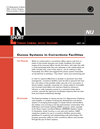|
DNA Information at Your Fingertips
Now online is www.DNA.gov, offering a wealth of information about funding, training, publications, and other resources related to the use of DNA technology in solving crimes, protecting the innocent, and identifying missing persons. Users can learn more about the Presidentís DNA Initiative, Advancing Justice Through DNA Technology, which seeks to enhance the role of DNA in the criminal justice system by reducing the current backlog of DNA samples, increasing crime lab capacity, and stimulating research and development.
Bullet-Resistant Vest Safety Initiative
Updated March 11, 2004
For more than 25 years, NIJ has worked with law enforcement to develop performance standards for and test new bullet-resistant body armor. On November 18, 2003, Attorney General John Ashcroft directed NIJ to implement a new initiative "to address the reliability of body armor...and to examine the future of bullet-resistant technology and testing." (Read the complete press release.) He also directed NIJ to issue an interim status report on the initiative. A copy of the press release and March 11, 2004, status report to the Attorney General is located here.
As part of the new initiative, NIJ will develop a testing program for used armor and accelerate research into the effects of aging on the ballistic performance of body armor. (Read the complete statement.)
Learn more about body armor:
Back to Top
Conferences
|
Work, Stress, and Health 2006:
Making a Difference in the Workplace
NIJ joins the American Psychological Association and the National Institute for Occupational Safety in convening the sixth interdisciplinary conference on occupational stress and health to address the constantly changing nature of work and the implications of these changes for the health, safety, and well-being of workers, including police and corrections officers.
Call for papers deadline: April 1, 2005
Proposal deadline for posters, papers, and symposia: May 1, 2005
For More Information: Work Stress and Health 2006: Making a Difference in the Workplace - Call for Papers
|
| |
|
NCJRS Conference Calendar online
 Visit the NCJRS Calendar
of Events for a searchable online listing of upcoming
criminal justice-related events.
Visit the NCJRS Calendar
of Events for a searchable online listing of upcoming
criminal justice-related events.
|
| |
Back to Top
Publications
Department of Defense Nonlethal Weapons and Equipment Review: A Research Guide for Civil Law Enforcement and Corrections
October 2004
|
 |
This NIJ Special Report (NCJ 205293) provides a detailed equipment review designed to give civil law enforcement organizations a greater understanding of DoD's nonlethal weapons program and currently used nonlethal technologies. Five categories of nonlethal technologies are reviewed: chemicals, electrical devices, blunt impact munitions, directed energy, and miscellaneous or hybrid systems. Appendix A discusses the selection process and includes descriptions of DoD's Joint Nonlethal Weapons Program and similar weapons programs in branches of the military, Special Operations Command, and the U.S. Coast Guard, as well as civil law enforcement agencies' less-lethal weapons.
Full text:
|
Duress Systems in Corrections Facilities
September 2004
|
 |
A duress system helps corrections facilities respond quickly and effectively to assaults on staff and other emergencies. Find out how to identify, select, and deploy the system that best suits your facility's needs.
Full text:
|
When Violence Hits Home: How Economics and Neighborhood Play a Role
September 2004
|
 |
Does intimate partner violence occur more in disadvantaged neighborhoods? For women, having financial problems in their intimate relationships and living in an economically distressed neighborhood combine to create greater risk of injury and violence. This NIJ Research in Brief (NCJ 205004) discusses who is most at risk and details the role that economic policies and employment practices might play in reducing the risk of intimate violence.
Full text:
|
NIJ Research Review, Volume 5, Issue 2
September 2004
|
 |
The NIJ Research Review is prepared quarterly by the National Institute of Justice (NIJ), the research, development, and evaluation agency of the U.S. Department of Justice. It contains short summaries of significant research findings from recently funded reports and lists titles of other recently completed projects.
Full text:
|
Voice Translators for Law Enforcement
September 2004
|
 |
Law Enforcement officers who are likely to encounter non-English-speaking individuals in the line of duty can benefit from the Voice Response Translator (VRT), and an electronic device that provides translations of basic commands in several languages. The VRT is a compact, easy-to-use, and battery-operated unit with fast response time and hands-free capability.
Full text:
|
Test Results for Software Write Block Tools: RCMP HDL V0.4, V0.5 and V0.7
August 2004
|
 |
These NIJ Special Reports present the results from testing the Royal Canadian Mounted Police Hard-Disk Write Lock V0.4, V0.5, and V0.7 against Software Write Block Tool Specification & Test Plan, Version 3.0. They document results against 21 test assertions (both mandatory and optional), describes the testing environment, provides an interpretation of the test results, and includes test results summary log files for 40 test cases. The results provide the information necessary for developers to improve tools, users to make informed choices, and the legal community and others to understand the tools' capabilities.
For results of RCMP HDL V0.8 and additional computer forensic tool test results, visit NIJ's Computer Forensic Tool Testing Project on the Web.
Full text:
|
Characteristics of Chinese Human Smugglers
August 2004
|
 |
This NIJ Research in Brief presents findings of a study that uncovered the inner workings of Chinese human smuggling organizations by going right to the source-smugglers themselves. Researchers found that most human smugglers are ordinary citizens whose social networks provide the necessary connections and resources to profit from human trade. Enforcement efforts need to consider the unique organization of smuggling enterprises and how smugglers are perceived by themselves and their clients.
Full text:
|
Hiring and Keeping Police Officers
July 2004
|
 |
This NIJ Research for Practice presents findings of a study that examined the recent experiences of police agencies nationwide in hiring and retaining sworn officers. Researchers found that while most agencies grew in the 1990s as a result of Federal funding and demands for service, 20 percent declined in size, most often because of fiscal or recruitment problems. Other findings include that agencies with Federal hiring funds kept the positions after the grants expired; 9 out of 10 recruits completed their training, although training is taking longer because of the growing complexity of police work; and many officers left their agencies after only a few years, often to work for another law enforcement agency.
Full text:
|
A Resource for Evaluating Child Advocacy Centers
July 2004
|
 |
This report gives Child Advocacy Center administrators the knowledge and materials they need to conduct either one-time or ongoing evaluations. It discusses three types of evaluations: program monitoring, outcome, and impact evaluations. The evaluations focus on achieving the standards established by the National Children's Alliance: child-friendly facility, multidisciplinary team, child investigative interview, medical examination, mental health services, victim advocacy, and case review.
Full text:
|
Vanguard Robot Assessment
July 2004
|
 |
The law enforcement community needs a low-cost robot that can reduce or eliminate the time of danger for a bomb technician who must inspect, x-ray, and disrupt an explosive device. This document discusses the Vanguard robot performance compared to other bomb-disposal robots. The Vanguard has a large percentage of the features required by law enforcement. Criteria for evaluation include cost and operating range.
Full text:
|
Gambling and Crime Among Arrestees: Exploring the Link
July 2004
|
 |
How is gambling related to crime? This NIJ Research for Practice explores gambling among arrestees in two U.S. cities-Las Vegas and Des Moines-and finds significantly more problem gambling among arrestees than in the general population. It also examines whether compulsive or pathological gamblers fit any particular profile, what percentage are arrested for felony and misdemeanor offenses, and how they differ from less serious gamblers. Consider this. Many compulsive or pathological gamblers got their start only after getting involved with drugs and alcohol or criminal activities. Criminals are at greater risk for developing pathological gambling habits but less likely to receive treatment, even though gambling is a prime motivation for many of their crimes. The authors suggest that jurisdictions must better prepare for the ill effects of problem gambling by, for example, developing screening and treatment programs in detention centers and jails to identify potential problem gamblers.
Full text:
|
NIJ Journal 251
July 2004
|
 |
Rural gangs and urban gangs differ in many respects. In this issue of the NIJ Journal, researchers suggest that policies and practices related to urban gangs may not apply to rural ones. Other articles discuss ways to ensure successful collaboration among law enforcement agencies, the Campbell Collaborationís review of criminal justice research, and NIJ's Data Resources Program. The "At-A-Glance" section summarizes recent research on child custody mediation and domestic violence, effects of child abuse, hung juries, problem-oriented policing in public housing, and frugal evaluations of programs.
Full text of the NIJ Journal:
|
Back to Top
Solicitations
|
See Funding Opportunities for a complete
list of NIJ solicitations issued this fiscal year. |
| |
|
Graduate Research Fellowship: 2005
Due Date: September 15, 2005. The Graduate Research Fellowship provides dissertation research support to outstanding doctoral candidates undertaking independent research on issues in crime and justice. Students from any academic discipline are encouraged to apply and propose original research that has direct implications for criminal justice. NIJ encourages diversity in approaches and perspectives in its research programs and awards these fellowships to encourage doctoral students to contribute critical and innovative thinking to pressing justice problems.
Full text of the Solicitation:
|
| |
|
Fast Capture Fingerprint/Palm Print Technology
Due Date: November 8, 2004. NIJ is seeking proposals to improve and advance the current state of technology for the capturing of 10 rolled-equivalent fingerprints and palm prints. As crime prevention and national security remain a top priority, requirements for the use of friction ridge detail information for the identification of latent impressions and for background checks have increased. Yet, both the existing use and the potential for expanded use of these identifications are limited by available technology and infrastructure designed to capture the fingerprint friction ridge detail that enables searches of databases. New technology with much greater convenience, speed, reliability, affordability, and accuracy must be developed to meet these screening requirements.
Full text of the Solicitation:
|
| |
|
W.E.B. DuBois Fellowship Program
Due Date: February 1, 2005. NIJ's W.E.B. DuBois Fellowship Program seeks to advance the field of knowledge regarding the confluence of crime, justice, and culture in various societal contexts. This Fellowship provides talented researchers early in their professional careers with the opportunity to elevate independently generated research and ideas to the level of national discussion and contribute to NIJ's national criminal justice research program by studying topics of mutual interest to the Fellow and the Institute. Researchers from all academic disciplines are encouraged to apply. Because of the focus of the Fellowship, NIJ strongly encourages applications from diverse racial and ethnic backgrounds.
Full text of the Solicitation:
|
| |
|
Solicitation for Crime and Justice Research
Due Date: September 28, 2004.
NIJ seeks proposals to conduct research and evaluation on topics relevant to State and/or local policy and practice in criminal and juvenile justice. Proposals can be submitted on a variety of topics in social and behavioral research, including but not limited to policing, community crime prevention, justice system improvements, corrections, and alcohol- and drug-related crime. The solicitation lists NIJ's priority areas for research. (In previous years, this solicitation was called "Investigator-Initiated Research.")
Full text of the Solicitation:
|
| |
|
Data Resources Program 2004: Funding for the Analysis of Existing Data
Due Date: October 23, 2004.
NIJ requests proposals to conduct original research using data from the National Archive of Criminal Justice Data (NACJD). NACJD houses quantitative and qualitative data from NIJ sponsored research and makes it available online for downloading machine-readable copies (in SPSS, SAS or ASCII) together with data dictionaries and study abstracts. The archive is maintained by the Inter-University Consortium for Political and Social Research (ICPSR) at the University of Michigan, and supported by NIJ. For more information on the Data Resources Program, click here.
Full text of the Solicitation:
|
| |
|



